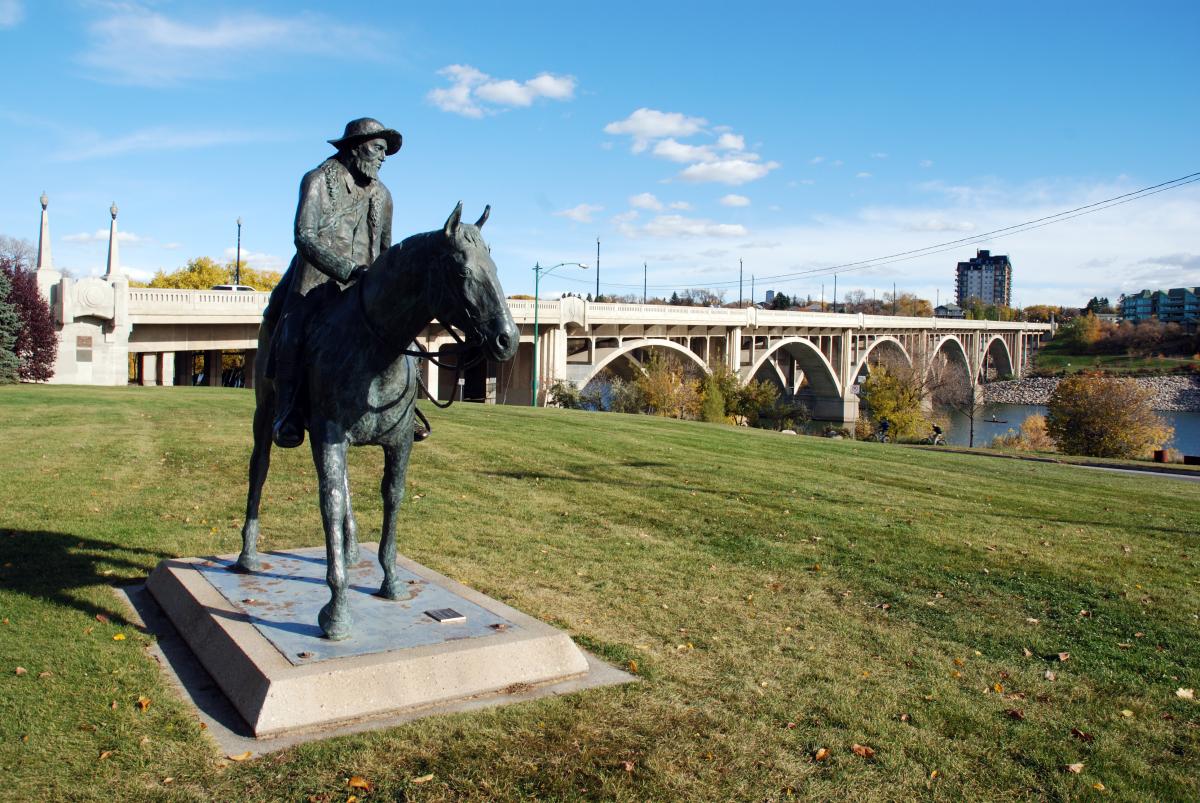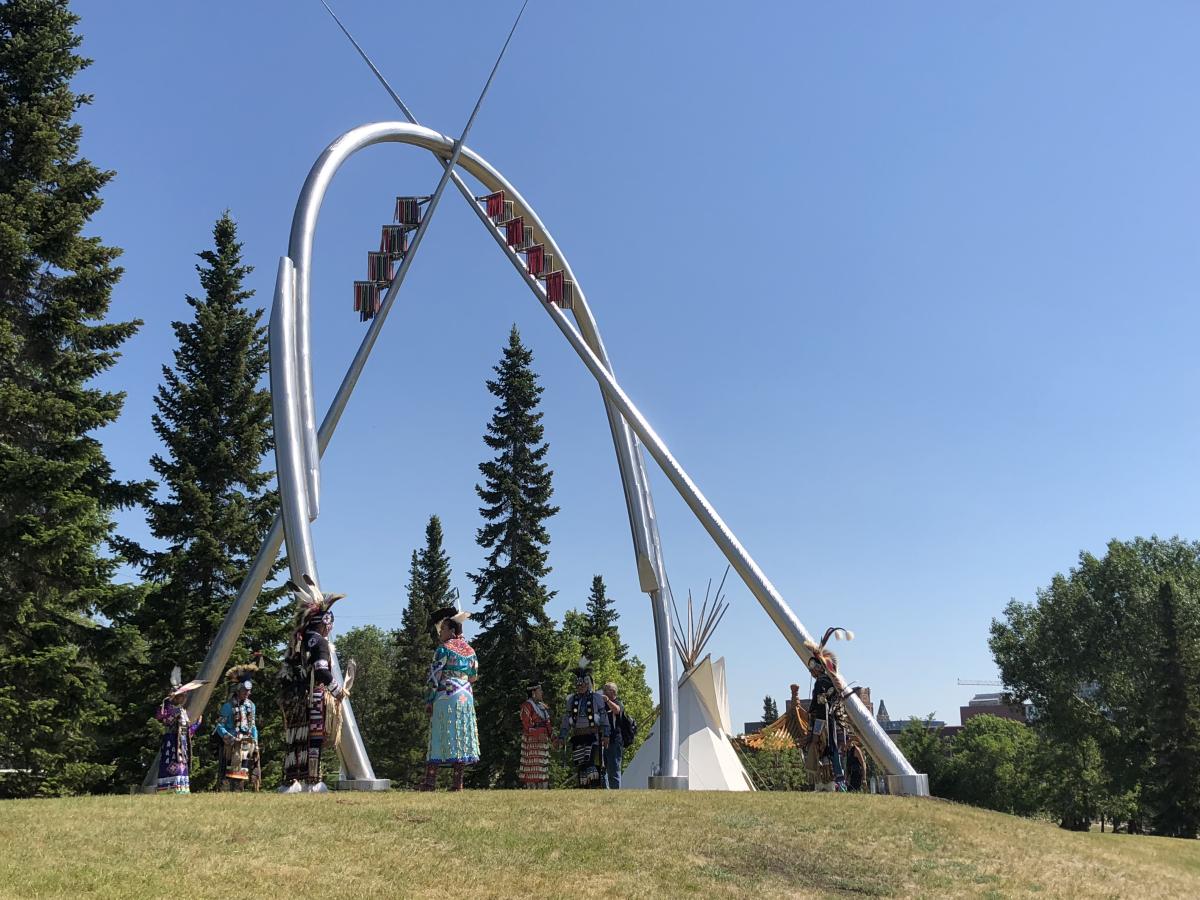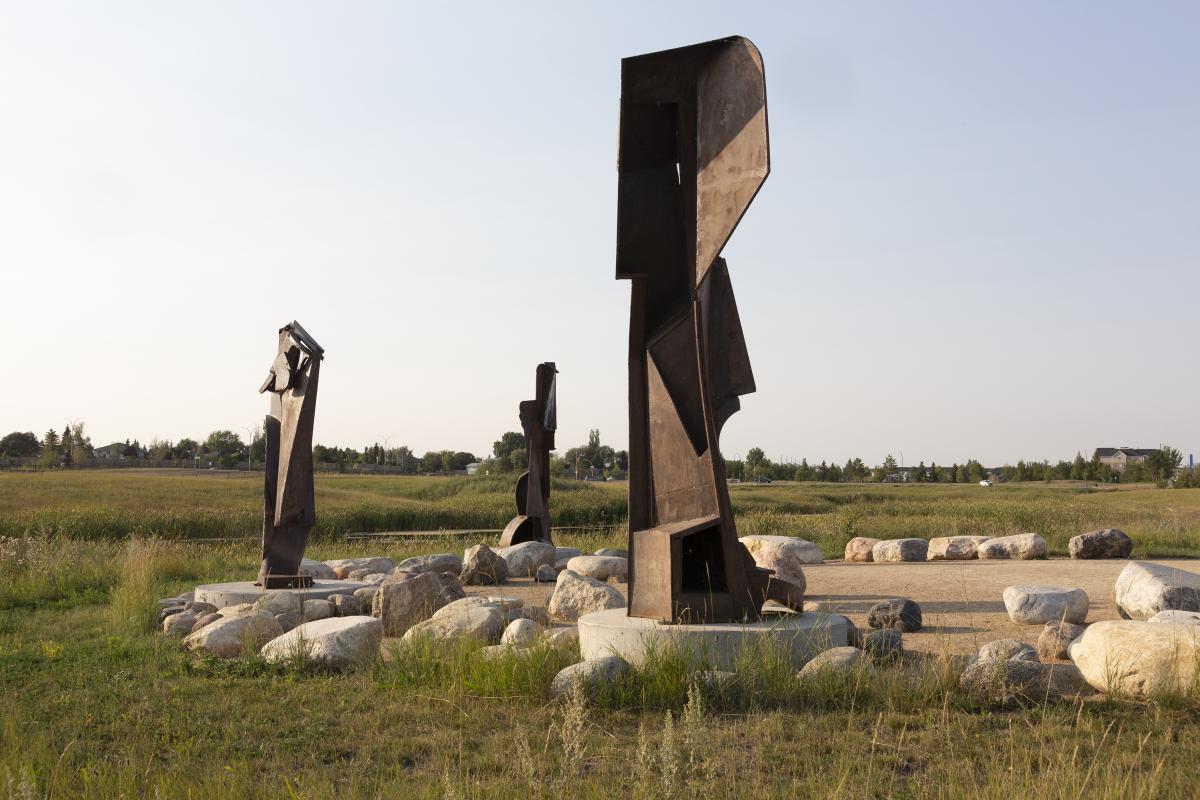Public Art

(Launch Time by Mel Bolen, Charley Farrero, Michael Hosaluk, Sean Whalley)
Public Art Collection
Saskatoon's public art collection numbers over 80 works of art. The majority of the art is located outdoors. Many pieces were acquired by donation. Several major pieces were commissioned and purchased with funding from the Government of Canada as a result of Saskatoon being named a Cultural Capital of Canada in 2006.
Browse the collection with our public art Story Map
Public Art Spotlight
Gabriel Dumont

Gabriel Dumont
Bronze
Bill Epp
1985
Friendship Park
Learn more in the Historical Memory and the Statue of Gabriel Dumont in Saskatoon's Friendship Park document by Cheryl Troupe that was previously published in Prairie History.
"The Coming Spring" Reconciliation Commemorative Artwork

“The Coming Spring,” by Canadian artist, Gordon Reeve, was commissioned by the Saskatoon Tribal Council and the City of Saskatoon, with funding from the Government of Canada through the Canada 150 Fund. Its creation is in response to the Truth and Reconciliation Commission of Canada’s Calls to Action, No. 79: Participate in a strategy to commemorate the contributions and history of Aboriginal peoples to Canada.
The 27-foot tall arch and two spires are constructed entirely of stainless steel that reflects the sun and moon. The longer 47-foot spire, pointing north, symbolically represents the First Nations’ long history. The 39-foot spire, pointing south, symbolically represents the history of the Métis Nation. Suspended high on each spire are moving chimes. The rustling and bell-like sounds the chimes make suggest the voices of children heard at a distance, representing the children taken by the residential system from all of the communities in Treaty Six Territory.
Mr. Reeve’s concept was selected from a list of three finalists by a group of stakeholders that included residential school survivors, First Nations and Métis Elders. This recommendation was reviewed and unanimously approved by the City’s Public Art Advisory Committee.
“The Coming Spring” is located within Reconciliation Circle in Victoria Park, north of the festival site and east of Spadina Crescent West. The location was identified by First Nations and Métis Elders as having particular significance because it has been the site of two reconciliation gatherings, is large enough to accommodate community events, and has a view of the park, trees, and South Saskatchewan River.
The artwork was installed in May 2018 and was officially unveiled during a special ceremony on June 20, 2018, as a symbol of reconciliation.
Since 2015, the City has been working with the Saskatoon Tribal Council, Central Urban Métis Federation Inc., Office of the Treaty Commission, and other community groups, leaders, and institutions in Saskatchewan, to promote reconciliation.
Hyde Park Public Art Project

In the 1960s a number of artists in Britain, the United States and Canada revolutionized the medium of sculpture by moving away from modelled, figurative works cast in bronze or carved in marble. Artists instead created large, abstract sculptures made of prefabricated steel and aluminum. British sculptor Anthony Caro (1924-2013) was the innovator in this way of working. Caro’s influence was strongly felt in Canada, especially on the Prairies, where his approach to sculpture was popular with young artists who saw potential in rusty old equipment found in farmers’ fields.
The Remai Modern Art Gallery collection contains a number of excellent examples of modernist sculpture by Canadian and international artists. Thanks to a partnership between the Remai Modern, the Public Art Advisory Committee and the City's Parks and Community Development Divisions, four sculptures (three by Edmonton artist Peter Hide and one by Saskatoon artist Douglas Bentham) are now on exhibit in the western portion of Hyde Park in the Lakewood Suburban Centre.
The sculptures will be on exhibit until September 2024.
Upcoming Projects
Material Recovery Centre Public Art
Sans façon has been selected by the City of Saskatoon Public Art Advisory Committee to fabricate and install three thematically connected artworks, the first of which will be located at the Material Recovery Centre (MRC) with the other two in areas of the city yet to be determined. All three pieces are to serve as wayfinding markers for the City’s new MRC's recycling facility and are to be installed by the summer of 2024.
More information will be added here as this project progresses.
More information on Material Recovery Centre can be found here.
Bus Rapid Transit (BRT) Public Art
Set to launch in 2026, the City of Saskatoon’s new Bus Rapid Transit (BRT) System will feature public art at various locations along the routes. In summer 2021, the City selected the artist collective LeuWebb Projects to develop a strategic and collaborative approach to BRT public art. This effort involved community engagement to address the ideas of theme, place, and movement related to the BRT stations. The result of this work is the BRT Public Art Strategy.
Information on the BRT Public Art Strategy is coming soon.
More information on the Bus Rapid Transit project can be found here.
Commemorations and Monuments
A commemoration is the honouring of the memory of a person, place, event, or idea. Generally speaking, commemorations are public, tangible and of significant interest or meaning to residents of Saskatoon. In 2013, Saskatoon City Council adopted a comprehensive policy to govern requests for commemorative art, statues, and monuments in Saskatoon.
Individuals and organizations interested in funding, designing and donating a public commemoration or monument are strongly encouraged to first read the Step by Step Guide to Commemorations in Saskatoon.
Step by Step Guide to Commemorations
